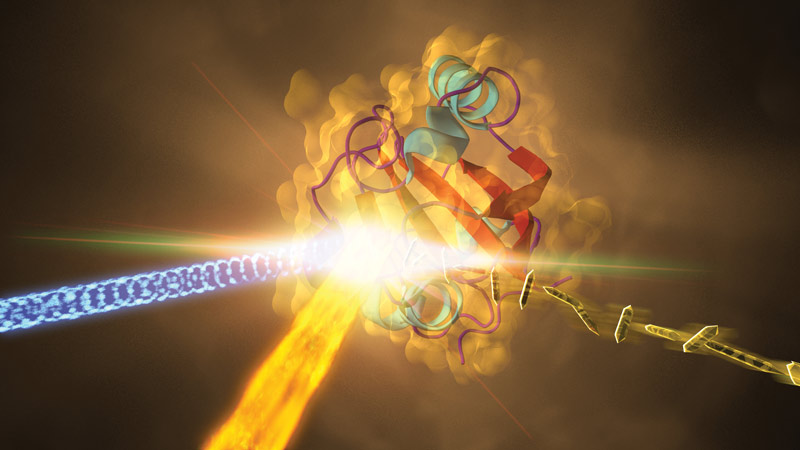Atom Smasher Doesn't SLAC Off
Fall
2015
Special Feature
Atom Smasher Doesn't SLAC Off
Venerable Particle Collider Find New Applications
By:Melinda Lee, Community Relations Officer at the Stanford Linear Accelerator Center in Menlo Park, CA

Want another reason to be excited about the 2016 Sigma Pi Sigma Quadrennial Congress? How about a tour of the Stanford Linear Accelerator Center (SLAC)? Join SLAC researchers for an inside look at one of the world’s most celebrated particle colliders. In anticipation of this event, we present here a quick look at how the machine has evolved in recent years...
When construction started on Stanford University’s linear accelerator (Linac) in 1962, the minds behind the massive machine hoped to gain a better understanding of the universe at its smallest scales. The idea was to accelerate electrons (or positrons) very close to the speed of light, collide them with protons or neutrons, and search the subatomic debris for signs of new particles.
Four years later, the two-mile-long accelerator turned on and began its illustrious career. It wasn’t long until it had demonstrated that protons and neutrons were made of even smaller particles called quarks. That work earned the 1990 Nobel Prize in Physics.
As years went by and facilities capable of achieving higher energies came online elsewhere in the world, SLAC moved in other directions. Machines at SLAC that had been built to push the frontiers of particle physics found new applications in chemistry and biology—including shooting what may be the fastest movies ever made.
The unusual films were made possible by additional pieces of equipment added to the Linac over the years. The first was the Stanford Positron Electron Asymmetric Ring (SPEAR), a curved tunnel used to accelerate electrons. It achieved electron–positron collisions with energies of up to 7.4 GeV. Two Nobel Prizes came out of work done at SPEAR: the 1976 prize for the discovery of the psi particle and the 1995 prize for the discovery of the tau lepton.
Electrons traveling around a circular path also shed radiation. That phenomenon allowed the SPEAR storage ring to evolve into the Stanford Synchrotron Radiation Lightsource (SSRL), which generates synchrotron radiation used in 30 experimental stations. Some 2,000 people use the facility each year to take advantage of the high-intensity light, which spans the spectrum from infrared to X-ray.
The Linac itself has undergone a recent transformation. It has been repurposed for two new experiments: the Linac Coherent Light Source (LCLS), which commandeered and modified a third of the original linear accelerator, and the Facility for Advanced Accelerator Experimental Tests (FACET), which laid claim to the rest of it.
LCLS is a free-electron laser facility that can deliver intense, coherent X-ray radiation; it’s an X-ray laser, if you will. Ranging in energy from 200 to 2,000 eV, the X-rays produced by LCLS have a much higher energy than those that could be produced by SSRL. To generate these X-rays, LCLS sends high-energy electrons through a series of closely spaced magnets, aka the undulator, that rapidly oscillate the electrons as the particles move through the spatially alternating magnetic field. These oscillations generate coherent X-rays directed into the six experimental stations that users from around the world compete for time on. Since it turned on in 2009, LCLS has been used by approximately 600 scientists each year and generated around 500 peer-reviewed publications.
One of the most interesting sets of experiments to come out of LCLS in the past few years made “molecular movies” that revealed the dynamics of chemical reactions. Scientists tracked structural changes of complex, ring-shaped molecules responding to a broken bond and evolving into linear molecules. One study focused on how 1,3-cyclohexadiene (CHD), a ring-shaped molecule similar to many that have biological and chemical importance, evolved after being excited by an ultraviolet laser pulse. The pulse initiated an unfurling of the ring shape, and subsequent pulses from LCLS’s X-rays proved the shape of the resulting molecule.
By sending in probe pulses at different time intervals from the initial pulse, scientists were able to use the experimental data and computer simulations to determine how the shape of the molecule changed over the first 200 quadrillionths of a second after opening. Researchers made a movie showing the evolution with a ridiculously fast frame rate. Each frame of the movie represented a time interval of “25 quadrillionths of a second—about 1.3 trillion times faster than the typical 30-frames-per-second rate used to display TV shows,” according to the SLAC researchers. SLAC has produced a YouTube video about this experiment that can be found at https://www.youtube.com/watch?v=HhmBKd-_sRM.
“This fulfills a promise of LCLS: Before your eyes, a chemical reaction is occurring that has never been seen before in this way,” said Mike Minitti, the SLAC scientist who led the experiment in collaboration with Peter Weber of Brown University. The results were featured in the June 22 edition of Physical Review Letters. “LCLS is a game changer in giving us the ability to probe this and other reactions in record-fast time scales,” Minitti said, "down to the motion of individual atoms." The same method can be used to study more complex molecules and chemistry.
As you tour the X-ray laser facility at the 2016 Congress, I encourage you to reflect on both the original technological innovations that allowed this awe-inspiring machine to open new doors in physics decades ago and on the recent innovations that have granted it new roles in the sciences outside physics. Often, the machines physicists design for their experiments have broader impacts than even their creators could have imagined. //
More Information
Learn more about SLAC science at www.slac.stanford.edu


